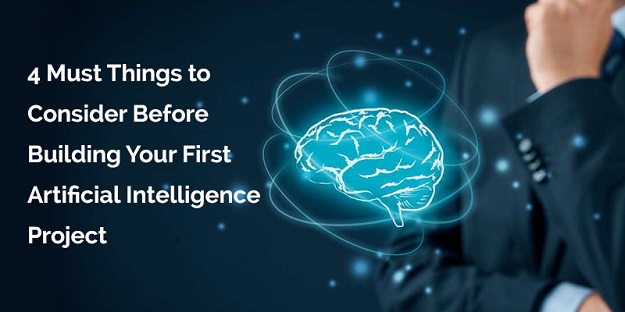Artificial intelligence saw a big stride in 2016. Got it how? In the form of digital personal assistants,business process automation and chatbots.Now we are at the almost end of 2017. This year has already seen many wonderful AI innovations. As a result, it set fireas the most talked technology topic of the year.
In fact, there are many key considerations an organization essentiallytakes into when building an AI solution. Sothey can expect true results that they ever wanted dig out from AI. Let’s see what you require to look into before building your first AI project:

1. Clean data:bad data results into bad results
Machine learning is the backbone of any AI solution. It requires a massive amount of data sets to be fed into to learn what exactly it requires to do. In fact, AI-powered solutions are capable enough to analyze data sets to find predictable patterns. But if you feed the machinedata without cleaning it, the system might produce half-boiled results, which also may be due tothe system can’t find the real values in the data.
According to a study by Xplenty, 30% of business intelligence professionals spend half of the total time spent in building an AI solution in cleansing data. They get it done using AI-powered tools or do manually. IBM and Amazon like firms do data labelling manually when the data is complex enough to understand by machines. AI-powered toolshelp analysts to cleanse data using algorithms that are built to clean up, and categorize the data. In fact, it is wonderful that today most of the mobile app development companies and other technology services companies out there have widened their service portfolio with chatbot development, sales and marketing automation and other AI-based services. It is really interesting to look out.
2. Integrated data/data warehousing
Businesses that can’t leverage vital data sources to extract business insights often fail to achieve a competitive advantage. You are probably aware of this. Today data is the most important aspect of any new initiative taken by enterprise and most of them are being built around the data. For example, analytical solutions and intelligent digital assistants.
According to EMC (research and analysis done by IDC),the data we create and copy annually will reach 44 zettabytes, or 44 trillion gigabytes by 2020. We have already been seeing the preface of it. Before building any AI solution, decision makers need to make sure all the valuable customer data that is generated from various sources within and outside the enterprise is centralized and integrated.Hadoop is still the most preferred way of getting done it. Big data solutions are built with robust APIs or data integration capabilities, most preferably SaaS solutions. SaaS solutions enable the integration of various kinds of data, including transactional, sales, marketing and CRM data.
Well unified data makes the thing pretty easier for AI solution building. It facilitates the process ofeducating machine learning systems and building a comprehensive AI system. Integrated data means better recommendations.
3. Strategic deployment
Since the technology is new and when you’re going to have a try of AI, strategic deployment is crucial. First, evaluate your existing IT infrastructure and look into business processes that can be impacted by AI.
The strategy should also focus on aligning other organizational priorities and strategies to lessen disruption and increase the possibility of quick adoptability. Disruption in the sense AI implementation process shouldn’t negatively impact customers – whether that isin marketing area or sales, customer care, or technical supportsection. And also you have to make sure that all channels that are customer-focused or employee-focused, including customer support section, web and mobile self-service, are able to deliver consistent experience.
4. Training data sets and processes: both are important
AI solution is not just about building a machine learning algorithm and deploying it to understand user behaviour. There is much more you have to work on apart from just building ML algorithm. What exactly those are?
Training data sets:If you don’t have enough data or if they are of low quality, the outcome that the machine produces are more likely inaccurate.
Training processes: Machine learning can be in two forms, either as supervised or unsupervised. In supervised training, ML model is fed up with both the training data and the intended output. In unsupervised training, output depends on the trends and dependencies in the training data.The AI-aspirant organizations have to choose their preference proactively.
Conclusion
Since it is new enough, AI has both challenges and opportunities. But the key to success is in overcoming challenges and leveraging opportunities. So most AI-aspirant businesses look for the help of AI service companies. If you’re among them, make a right choice of choosing expert AI service company. So you can yield the best breed out of your future-focused investment.
